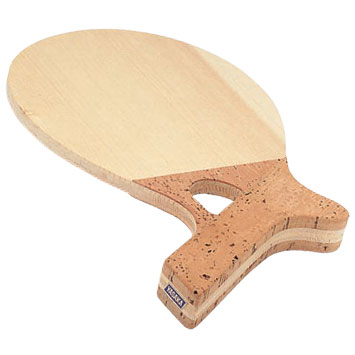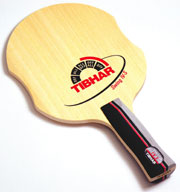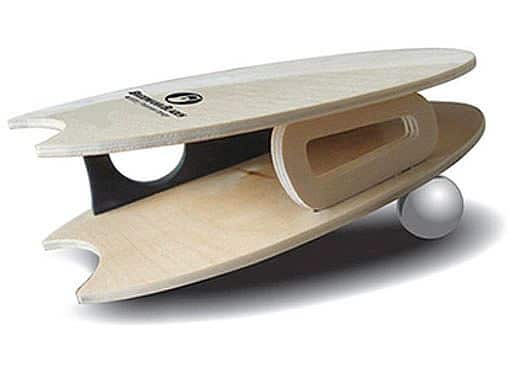Here are some table tennis rackets (bats) designed with different exciting shapes. I’ve never used any of them, but I imagine some of the designs could improve play (or at least not hinder freedom) once one got used to them. They are pretty interesting-looking rackets, though!
Take a look!
This racket is a part of the “Tenaly Series” put out by the Japanese maker Nittaku. It is the Tenaly Original Table Tennis Racket, and the maker assures that penholders can use it.

Then next is the “Sound”, also by Nittaku. This racket is more like a table tennis “paddle” in shape and design. The ads for it say that it’s made for shakehand players primarily.

Tibhar also puts out some interestingly colored designed table tennis blades, including the Swing IV-S racket. This is the racket used by French player Damien Eloi. The shape of the racket is often described as guitar or violin shaped.

Here’s a photo of Damien Eloi playing with the Swing IV-S.

Table of Contents
ToggleRacket Like a Glove
Table tennis is a sport enjoyed by many people around the world. Some people like the shakehand blade, while some people like the penhold blade.
However, for this table tennis racket, there is only one way you can hold it. The designer has innovatively designed the table tennis racket in the form of a glove. It would help if you put your hand in the middle of the two blades’ combination, and you can play the ball on both forehand and backhand.
I don’t know if it is inconvenient to play in this way. People who don’t know how to play ping pong will feel that it is easier to play with this table tennis racket.

Brodmann Blades Glove Type Table Tennis Racket
I first heard of this through a Japanese table tennis site, even though Brodmann Blades are based in the U.S. The ITTF has not yet approved this particular table tennis blade, but they claim a lot of enthusiasm about this new design.
The racket is made like a glove with no handle. Your hand fits in between the two sides of the racket. The manufacturer claims that this provides a better feel for the ball and offers more control.
Some of the comments I’ve read over in Japan were concerned about reduced power and reached and the possibility of injuring the hand that’s in the racket if you happen to slash it across the table.
I think it could have some significant uses as a recreational or training device, especially for beginners who might benefit from getting a more direct feel on the ball and how the ball plays off the racket.
Knowledge of Table tennis Racket Handle
Shooters will polish the handles of their guns with their palms. Gamers will carry their mouse and keyboard around. We, as human beings, will feel each other’s sincerity and heart with a handshake. So, like a table tennis fan, have you ever felt like the “left hand is holding your right hand” on the handle of your table tennis racket?
Traditional Penhold Handle
Today’s penhold handles are becoming more and more assimilated. They are mostly cones with elliptical cross-sections and small angles. There are two reasons for this:
First, the use of the penhold handles is mainly Asia players where the palm conditions are not much different.
Second, the penhold grip method determines that the contact range between the hand and the handle is limited for half. The index finger’s root is placed against the back of the handle, and the area between the thumb and index finger is naturally covered. The shape of the handle does not need to be varied, and the handle’s appearance is the focus for all manufacturers.
However, there are subtle differences between different brands and models of the blades. The main differences are in width and the thickness of the handle. The mainstream rackets are having a handle with a length of around 82mm.
Yasaka penhold blade is quite popular to be used by Asia players. The inner performance is the main reason, and the handle is also a must-have.
The surface of the Yasaka blade is slightly flat and wide, and the taper is not significant. Flat means that the handle wood is thinner, especially the reverse side is thin, and the cross-section of the blade in hand is larger.
Handle with Wider Width
Some table tennis blades are specially designed with a slightly wider handle width, and the contact area between the thumb and the index finger is too large and too flat. This type of handle is not suitable for some players.
Therefore, many table tennis racket brands have the same taper shape with a slightly rounded cross-section, making the grip give a comfortable feel to the player.
Round Shape Type
Another popular type of handle is the thin round shape with a more round cross-section. Although the thickness is not so thin, the taper increase makes the handgrip not too thick.
This kind of delicate handle grip is just as lovable as a small and cute gadget. It is very flexible. It is suitable for playing a variety of straight and delicate styles. The backhand is very fast, and it is easy to use in your hands.
Read also: Table Tennis Rubber Buying Advice

Warren Davies
Hi, I’m Warren Davies, a table tennis addict who loves sharing tips, reviews, and everything you need to level up your game. I’ve spent years playing, testing gear, and geeking out over the sport, and I’m here to make things simple and fun for players of all levels. When I’m not writing, you’ll probably find me perfecting my forehand or trying out the latest paddle.







